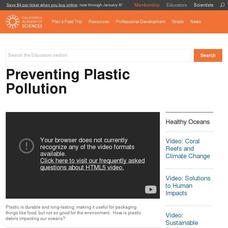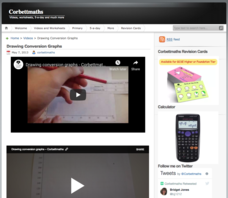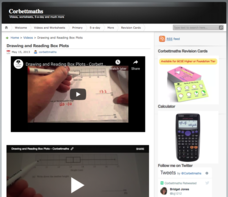Nature League
What Is Life? - Lesson Plan
The first lesson in the five-part What is Life? series addresses the definition of life. It discusses characteristics, why the concept of carbon-based life is important, and the macro-molecules of life on Earth.
Nature League
Biodiversity and Extinction Vulnerability - De-Natured
Science benefits everyone, so why is the language in journal articles so difficult to understand? The third video in the four-part series on Biodiversity breaks down a journal article so everyone understands the content. The article...
Nature League
Everyday Biodiversity - Field Trip
Many pupils associate biodiversity with the rain forest or coral reefs, but there is so much more to learn. Join a virtual field trip into a pharmacy to explore the importance of biodiversity in all forms. The second video in a four-part...
Nature League
Increasing Night Life of Mammals - De-Natured
How do animals avoid predators, including humans, if they can't move to a new habitat? The third video in a four-part series explains a recently published article on the topic of adaptations. Many mammals shift their schedules to a more...
Nature League
What Are Adaptations? - Lesson Plan
Texas short-horned lizards shoot blood out of their eyes to deter predators. The unique adaption allows them to thrive in a hostile environment. Pupils learn more about this and other adaptations of plants, animals, and humans in the...
Veritasium
World's First Car!
When scientists first wanted to study car safety, they didn't use crash test dummies—they were the testers! A short video traces the history of car safety innovations in engines, frames, brakes, and more.
California Academy of Science
Preventing Plastic Pollution
While plastics don't biodegrade, they do photodegrade, creating issues in Earth's oceans. The final video in the Healthy Oceans series explains why plastic in oceans causes so many issues. the narrator explains the impact of plastic...
California Academy of Science
Solutions to Human Impacts
The phrase think globally, act locally inspires scholars to address pollution. After learning about invasive species, nutrient pollution, and dead zones, discussion questions help scholars link the concepts. They then apply knowledge of...
Nature League
Nature + Engineering
Viewers observe many nature-inspired examples in technology, household items, and health care with the final video in a five-part series on Evolution and Speciation. The video focuses on human engineers inspired by earth's wonders.
Nature League
One Fish, Two Fish, Red Fish, New Fish - De-Natured
Sometimes it seems like high-level journal articles speak a different language. The third video in the five-part series on Evolution and Speciation breaks down one recent article from a science journal. It explains what the researchers...
Nature League
Preserving Montana's State Fish - Field Trip
Many people know in cases with a lot of in-breeding, the species becomes weak and less likely to survive long term. Now learn about how out-breeding also leads to the same result. The second of five videos on Evolution and Speciation...
TED-Ed
The Journey to Pluto, the Farthest World Ever Explored
In 2006, scientists launched a mission to explore Pluto and beyond. In 2015, after a challenge just days before approaching Pluto, New Horizons completed its first objective. The mission continues, and detailed reports are set to begin...
Corbett Maths
Frequency Polygons
How many ways can you think of to display data? A quick video lesson describes the process of creating one of them, a line graph, which is also referred to as a frequency polygon. After creating the graph, the instructor models how to...
California Academy of Science
Think Before You Eat
Small changes in individual diets add up quickly, which is the theme of the ninth lesson in the 13-part Our Hungry Planet unit. Viewers watch a video to learn basic facts before reading a handout and discussing their own choices.
California Academy of Science
Nuclear Energy: Is Fission the Future?
Nuclear energy powers the Mars rovers as well as provides energy in more than 30 countries around the world. While some believe nuclear energy is the future of energy production, others worry about the risk factors and radioactive waste....
PBS
When We First Walked
Out of all mammals, only humans walk on two feet. Discuss the current scientific understanding of when this specific adaptation began. A video shares facts about many different species and theories about why the shift occurred. New...
PBS
Life, Sex, and Death Among the Dire Wolves
Scientists know a great deal about extinct dire wolves thanks to a large number fossilized in one geographical area. They lived in groups, hunted opportunistic or wounded prey, and were fierce in battle and sex. Learn more with an...
Corbett Maths
Reading Cumulative Frequency Graphs
Creating a cumulative frequency graph is one thing, reading them is another. A thorough video lesson explains how to find key information from a cumulative frequency graph. The instructor demonstrates the best way to read the graph and...
Corbett Maths
Drawing Cumulative Frequency Graphs
What's the difference between frequency and cumulative frequency? Young scholars consider the question as they create a cumulative frequency graph. They watch as the frequency totals grow to create a new shape of the graph.
Corbett Maths
Conversion Graphs
Add a new method of converting units to your repertoire! A video lesson describes how to use a graph to convert units. The lesson focuses on miles-to-kilometers and kilometers-to-miles conversions but applies to any type of conversion.
Corbett Maths
Drawing Conversion Graphs
A conversion graph makes quick work of determining unit conversions. A video lesson demonstrates how to create and use a conversion graph. Learners then demonstrate their understanding with provided practice problems.
Corbett Maths
Comparing Box Plots
Stacked box plots create an informative visual display. Using a video lesson, scholars compare data from box plots plotted on the same number line. They use both the visual display and the key intervals to make conclusions.
Corbett Maths
Drawing and Reading Box Plots
Box and whiskers have more to do with data than they do with cats! A video lesson describes how to plot, analyze, and compare box plots. Mathematicians first learn to create a box plot and then how to use information about the quartiles...
Corbett Maths
Reading Bar Charts
Not just a bar graph—it's a double bar graph! Young scholars learn to read a double bar graph as they view the instructional video. The video highlights the individual data as well as shows a comparison between the two sets of data...























